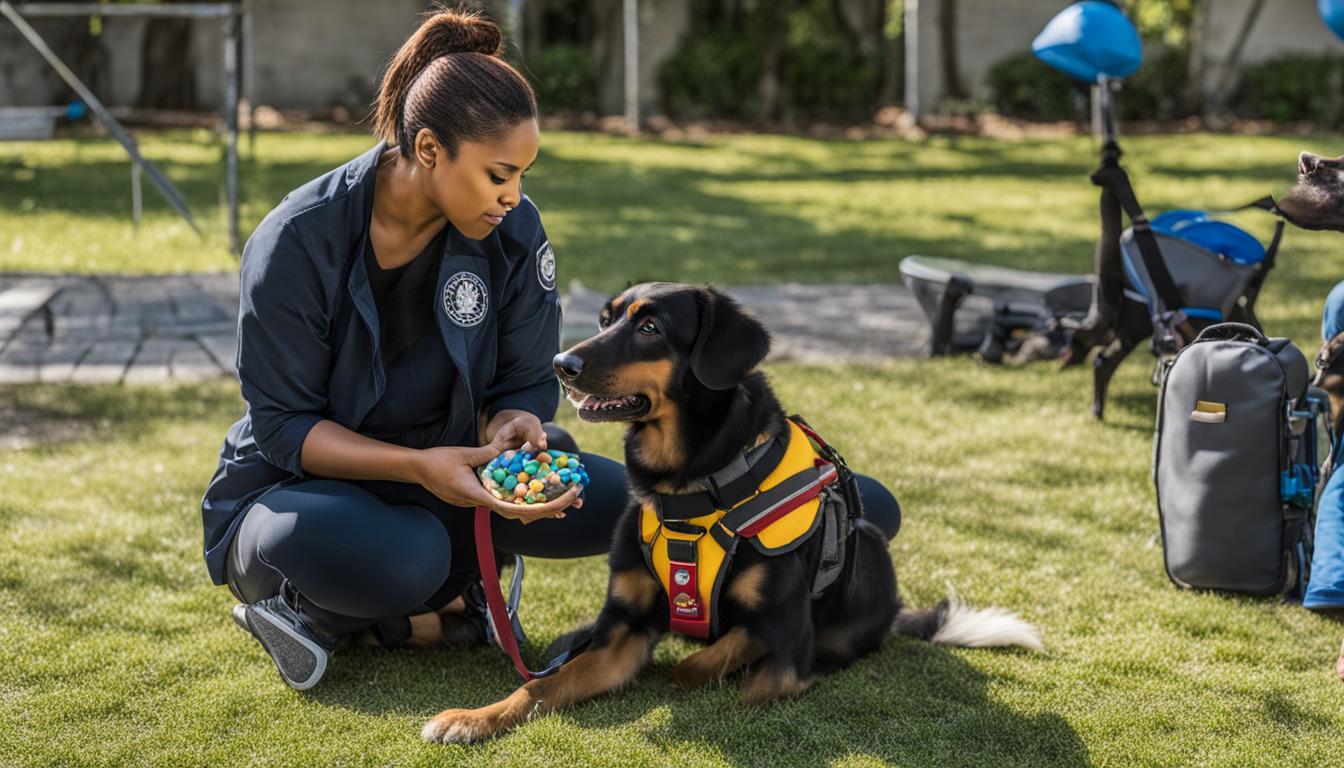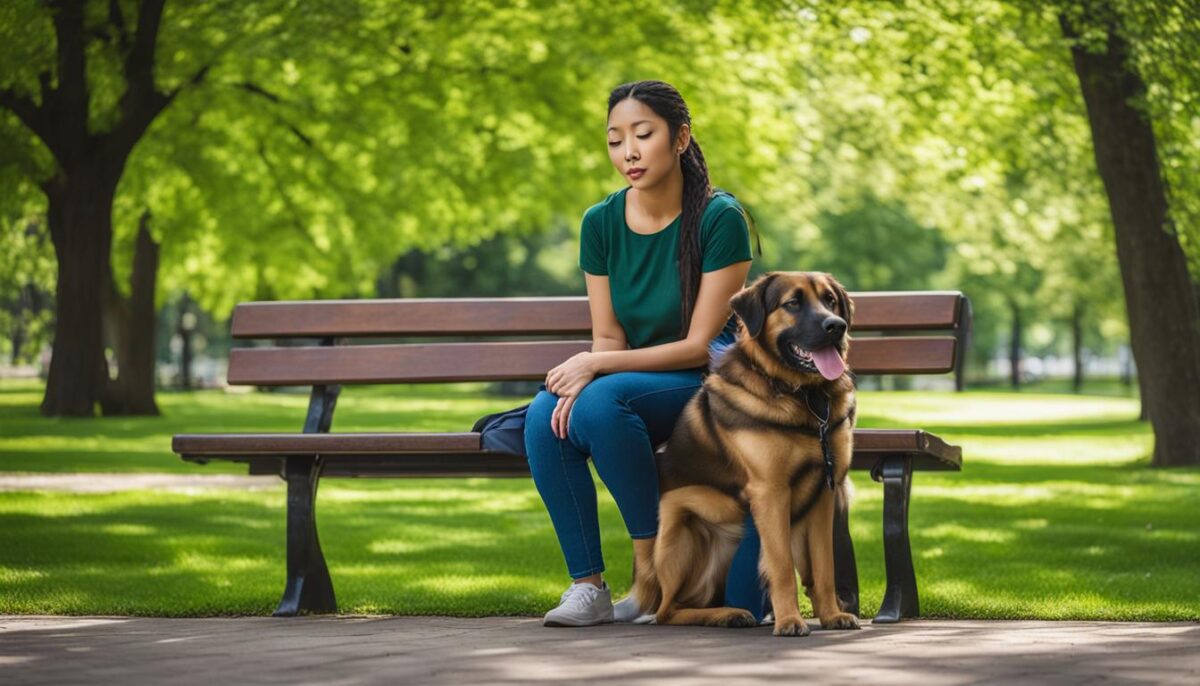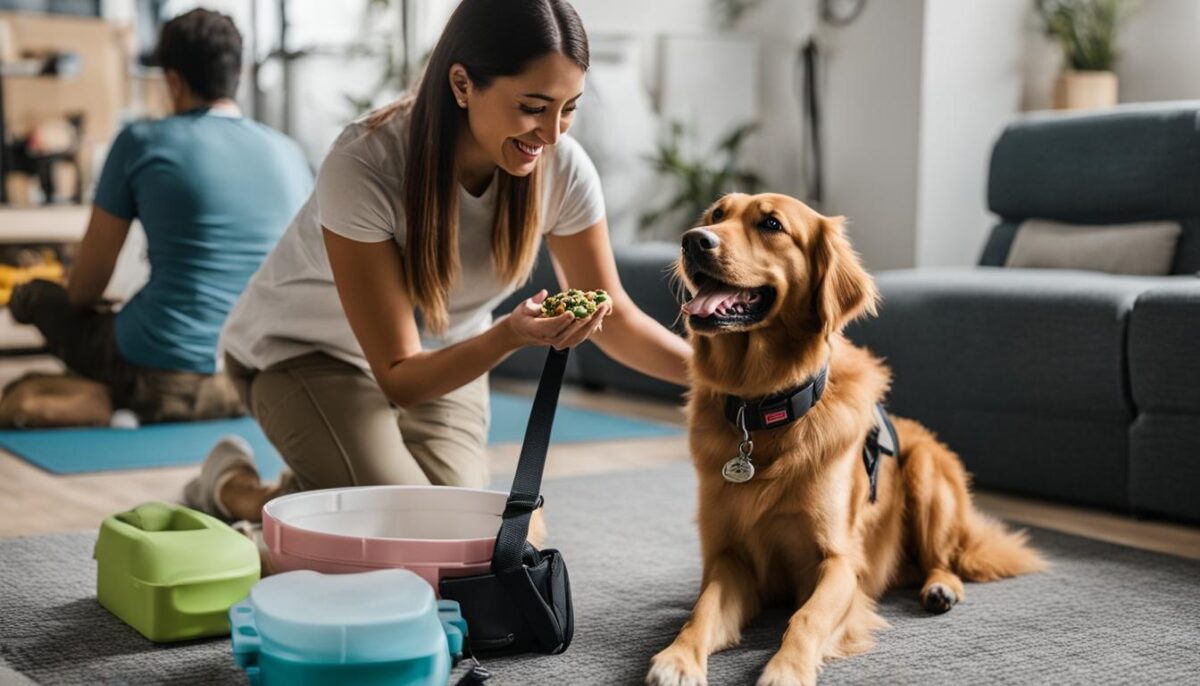Finding peace when you feel anxious can be tough, but a service dog might help. These amazing dogs offer anxiety relief and are friends who can do special tasks. To have a dog like this, certain training tips and steps are needed. They are trained to help people who find some things hard because of a health issue. This is called disability assistance. You can learn a lot about how to train your dog to be a great helper with the right guide.
Key Takeaways
- Service dogs are trained to help you if you feel really worried or scared.
- Training these dogs includes special steps that teach them how to be good helpers.
- To start, you need to know some important training tips.
- The training process includes learning how dogs can help with different health problems.
- Following a guide makes service dog training easier for you and your dog.
Understanding Service Dogs for Anxiety
Do you know there are special dogs trained to help people who have trouble with things like feeling very worried or scared? These dogs are super helpers, called service animals. The law looks at them in a special way to make sure they can go almost everywhere with their person.
Defining a Service Dog’s Role and Legal Definitions
What makes a dog a service animal, you ask? In the United States, a big important rule called the Americans with Disabilities Act (ADA) says that if someone has a big problem doing everyday things because of how their body or mind works, they might be able to have a service dog. Service dogs are trained to do special jobs that really help their person with their disability.
Emotional Support vs. Service Dogs: Knowing the Difference
Now, you might have heard about emotional support animals. They are also pets that help people who feel very worried or sad, but they don’t do special jobs like service animals. This means they don’t always get to go everywhere like service dogs can. Service dogs have practice in doing things that are super important for helping people with their disability, like being calm in busy places.
The Temperament and Traits of an Effective Anxiety Service Dog
A service dog for someone who feels scared or worried needs to be really good at staying calm. If their person is having a hard time, the dog knows just what to do without getting upset themselves. They have a big heart for helping and don’t get scared or distracted easily. Just like a superhero, they are always ready to help!
Here’s a little chart to show you some differences between super helper dogs and comfort pets:
| Type of Animal | Special Training | Legal Rights | Job |
|---|---|---|---|
| Service Dog | Yes, lots! | Can go many places | Does tasks to help disability |
| Emotional Support Animal | No special tasks training | Limited places | Offers comfort |
Remember, service dogs are like best friends who are always there to help you do things that might be hard to do on your own. They’re trained just for you and follow the ADA rules so you can feel safe and less worried.
Assessing Your Need for a Service Dog
Living with anxiety or certain health conditions can be tough, and you may wonder if a service dog could help. Think about what a service dog could do. It could make life easier and help you feel better. A lot of people with disabilities find joy and help with a service dog. But getting a service dog is a big step.
A disability assessment is the first big part. You talk to a doctor to see if a service dog is a good choice for you. This chat is important because service dogs can help with many things, but you need to be sure they can help with your special needs. If you’re living with anxiety, a service dog might be just what you need.
| What to Consider | Details |
|---|---|
| Service Dog Tasks | Can the dog help with your daily life and make you feel safer? |
| Costs | Do you understand how much money and time you need to train and take care of a service dog? |
| Doctor’s Advice | Has a doctor said a service dog could help with your health condition? |
| Commitment | Are you ready to take care of a dog and train it every day? |
Also, you need to check service dog eligibility. Not all health conditions need a service dog. Some, like post-traumatic stress disorder (PTSD) or depression, could make you eligible. If you can give time to train and take care of the dog, it may work out great for you.
If you say yes to these things, a service dog might be a good idea. It’s a big help for many who are living with anxiety. Now, are you ready for a furry friend to help you every day?
How to Train a Service Dog for Anxiety
If you’re looking to train a service dog to help with anxiety, you’re on the right track! Service dogs are amazing helpers that can do tasks to make life easier for people with anxiety. Let’s look at how you can select the right dog and teach it to become a great service dog.
Choosing the Right Dog: Temperament and Health Considerations
The first step is **dog selection**. It’s important to pick a dog that is calm, friendly, and healthy. A dog like this will be better at helping you with your anxiety because it will be able to stay focused and not get too stressed itself.
Developing a Training Plan: Goals and Milestones
Once you have the right dog, you’ll need to make a **training regimen**. This plan will help you and your dog know what to learn and when to learn it. Setting goals and marking milestones will keep you both on track.
Essential Commands and Tasks Specific to Anxiety Disorders
You’ll also teach your dog special **task training**. These are things your dog will learn to do to help you when you’re feeling anxious. For example, the dog might learn to remind you to take your medicine, or it might learn to give you a nuzzle when it sees you’re not feeling happy. Training these tasks is a big part of how your dog will help with your **mental health assistance**.
Training a service dog takes time and patience, but it’s worth it! Remember, your dog wants to help you, so working together and being kind to each other during training is key. With love and practice, your dog will become an amazing helper for your anxiety.
Training Methods for Anxiety Service Dogs
When you’re training an anxiety service dog, the goal is to teach them with kindness. You can do that using some smart ideas like giving them treats and using a special tool called a clicker. They learn that when they do something good, they get something yummy or hear a fun sound. That way, they start to know when you need help.
Using Positive Reinforcements: Treats and Clickers
Using positive reinforcement is a friendly way to train your dog. It means that when your dog does something you like, you give them a treat. It’s like saying “Great job!” in dog language. You can also use a clicker to make a sound that tells your dog they have done something well.
Association with Anxiety: Reward-Based Learning
A big part of training is making a connection between good things, like treats, and the moments you might feel worried. This is called behavior association. When your service dog sees that you’re getting anxious, they’ll learn to help because they know they’ll get a reward. It’s one of the psychiatric training methods that work really well.
Responding to Tells: Training Your Dog to Notice Anxiety Symptoms
Another cool trick is to teach your service dog to pick up on anxiety cues, which are like little hints that you might not be feeling okay. Dogs can learn to notice if you start breathing fast or feeling restless. This helps them jump into action right when you need them.
| Dog Training Method | Why It’s Useful | Example of Use |
|---|---|---|
| Positive Reinforcement | Makes learning fun for the dog | Giving a treat when the dog sits calmly |
| Behavior Association | Helps dogs connect actions with rewards | Treat after dog responds to anxious behavior |
| Noticing Anxiety Cues | Service dogs learn to help right when needed | Dog nudges you when you tap your foot quickly |
Conclusion
The path to training your service dog for anxiety is full of steps. You need to put in time and care. It’s like growing a plant – with the right seeds and a lot of love, you’ll see it bloom. Your dog will learn to help you with your anxiety and be a friend who makes each day brighter. Through your hard work, you will see your dog become not just a pet, but a helper who stands by you.
Using the right training tricks, like when you give your dog a treat for doing something great, helps a lot. This way, your dog learns how to be there for you when you’re feeling anxious. Think of it like a game where both of you can win! And the stronger the bond between you and your dog, the better they can help. It’s amazing how a dog can learn to be a calming friend and guardian.
When you reach the end of your training adventure, two things are for sure. First, the bond you have with your dog will be super strong. Second, you will see your buddy turn into a real service dog. It’s not just about getting a service dog certification; it’s about feeling better and more free in your day-to-day life. Remember, training a service dog takes patience, but you’re building a friendship that can change your life.
FAQ
What defines the role of a service dog for anxiety?
A service dog for anxiety is considered “medical equipment” under the Americans with Disabilities Act (ADA). They are specially trained to perform tasks that help mitigate the symptoms of a handler’s disability, such as alerting to impending anxiety attacks or providing deep pressure therapy.
How do service dogs differ from emotional support animals?
Service dogs are trained to perform specific tasks to aid with a disability, while emotional support animals (ESAs) provide comfort but are not trained for specific tasks. Unlike ESAs, service dogs are granted legal protections under the ADA.
What are the ideal temperament and traits of an anxiety service dog?
The ideal anxiety service dog exhibits emotional stability, calmness, and non-reactiveness. These dogs should be able to work through their handler’s panic attacks with eagerness and without being driven by their own anxiety or worry.
Who is eligible for a service dog under the ADA?
Individuals with a physical or mental impairment that significantly limits major life activities might be eligible for a service dog. Conditions such as post-traumatic stress disorder (PTSD) or severe depression could qualify someone, provided they can commit to the training and care of the animal.
What is involved in selecting the right dog for service training?
Selecting the right dog for service training entails assessing the dog’s temperament and health to ensure they can effectively handle the tasks required of them. The dog must be able to consistently perform tasks under stress and have a suitable disposition.
What are the components of an effective training plan for a service dog?
An effective training plan for a service dog includes setting clear goals and milestones for the dog’s performance, training the dog in essential tasks specific to the handler’s anxiety, and tailoring the tasks to address the symptoms experienced during high-stress situations.
How does positive reinforcement work in training service dogs for anxiety?
Positive reinforcement involves the use of treats and clickers to reward desired behaviors. Service dogs are trained to associate these rewards with specific actions that aid their handler’s anxiety, encouraging them to repeat those behaviors when required.
Why is understanding and responding to anxiety ‘tells’ important in service dog training?
Training a service dog to respond to “tells,” or signs of their handler’s anxiety, is crucial because it enables the dog to recognize different levels of anxiety or psychiatric episodes. This allows the dog to respond appropriately when the handler is experiencing stress or is in need of support.
How can a service dog for anxiety improve the life of someone with a disability?
A service dog for anxiety can significantly increase the independence and confidence of someone living with a disability. They assist by performing tasks that mitigate aspects of the disability, thus allowing their handlers greater freedom and overall improved quality of life.
What are the legal rights of service dog handlers under the ADA?
Under the ADA, service dog handlers have the right to be accompanied by their service dog in most public places and accommodations. Service dogs are not considered pets but are recognized as necessary aids for their handlers’ disabilities.


